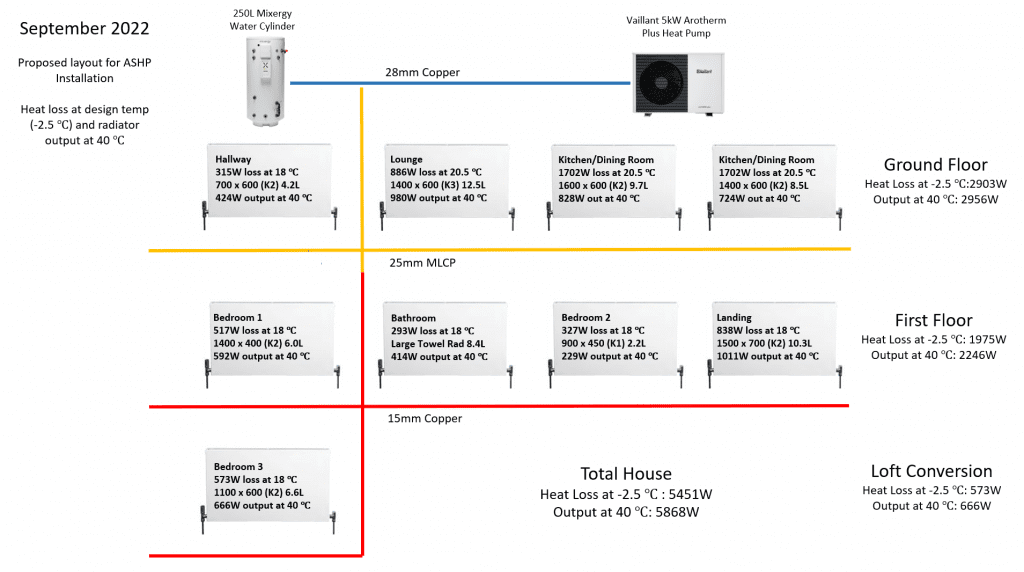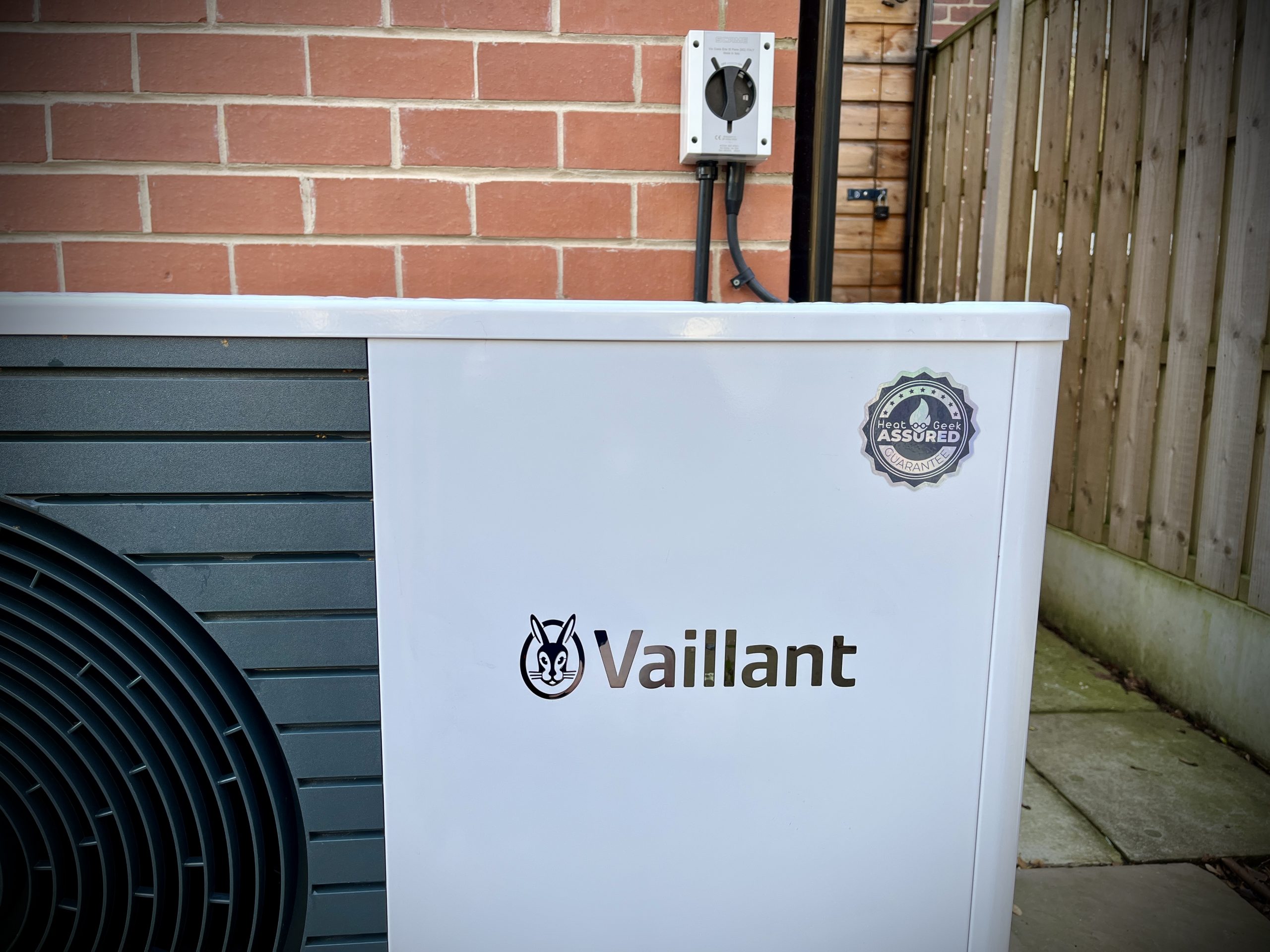My Heat Pump Installation Summary
- 5kW Vaillant Arotherm Plus heat pump
- 250L Mixergy Hot Water Cylinder with plate heat exchanger (in custom built plant room)
- Senso comfort RF indoor controls
- 12L IMI Statico expansion vessel
- Scame grey isolator from Midsummer Wholesale
- Water based system, no glycol, no inhibitors, no chemicals
- System cleaned with Thorough Flush to VDI 2035 and treated with resin
- Fully open radiator circuit, no low loss header etc
- Anti Freeze valves
- IMI Eclipse flow control valves on each radiator (we have replaced these with standard valves and balanced the rads to DT5)
- TRV fitted to bedroom radiators
- Spirotech air and dirt separation protector
- Caleffi automatic air vent
- Primary Pro outside insulation by Condensate Pro

You can read all the about the Mixergy cylinder installation and Plant Room project here: https://energy-stats.uk/plant-room-project/
The cylinder project was completed 9 months prior to the heat pump going in, which meant I ran the Mixergy on a combination of overnight cheaper tariff electricity and PV diversion from our Solar and myenergi Eddi diverter. This worked very well through the summer, but we wanted the heat pump in before the winter when solar generation drops off dramatically.
The 5kW heat pump replaced a 32kW Vaillant Ecotec combi-boiler as part of the government boiler upgrade scheme.
Note: the combi had plenty of life in it and was passed onto someone else to use. So not scrapped.

All heating and plumbing work was undertaken by Damon Blakemore Plumbing, Heating and Renewables in Sheffield.
https://blakemoreplumbingandheating.co.uk/
The install was completed as part of the Heat Geek assured scheme.
https://www.heatgeek.com/heat-geek-assured/
And all electrical work was done by Mike Haver of Practical Property Services.
https://www.practicalpropertyservices.co.uk/
Retrofit changes made for the heat pump
- Of the 8 old radiators in the house, 6 were replaced with new higher output ones
- 1 additional new radiator installed in dining room
- 15mm copper and 10mm plastic pipework under the ground floor was replaced with 25mm MLCP
- 10mm plastic pipe up to loft extension replaced with 15mm copper pipe
- 5 x IMI Eclipse valves (to control flow rate / balance radiators) fitted on smaller radiators
- 4 x IMI Eclipse 300 high flow valves installed on larger radiators (larger radiators need more flow)
Note: After monitoring for a while, we are thinking that the IMI radiator valves may be restricting flow, so we are considering removing them.

System Design Details
Design Outside Temperature: -2.5℃ (Sheffield at 100m elevation)
Design outside temperature (DOT) targets:
- Calculated heat loss at DOT: 5.5kW
- Target flow temperature at DOT: 43℃
- Target liveable rooms temp: 20.5℃
- Target bedrooms temps: 18℃
- Target whole house overnight setback: 19℃
Full details of the design, measurements, calculations about the heat loss and before/after diagrams are all included in my ‘What size heat pump?’ article. Well worth a read.
Is the Heat Pump Noisy?
Absolutely NOT. When heating there is a hum from the Arotherm heat pump. But it is drowned out by road noise, birds tweeting and wind blowing in the trees.
When doing a hot water run, ie when it’s working harder. The noise does go up a notch, but you still can’t hear it from a few metres away.
It has certainly passed both the wife test and the neighbours too.
Honestly, my neighbours combi boiler is noisier than my heat pump.
All of these concerns should be addressed early doors during the MCS noise impact assessment. ie, distance from neighbours windows, dB output of the heat pump, any barriers in the way etc.
This is all covered in the MCS permitted planning document MCS 020.
https://mcscertified.com/wp-content/uploads/2021/10/MCS-020.pdf
Monitoring Setup
- Open Energy Monitor Heat Pump HAT connected to Raspberry Pi
- Sharky 775 heat meter (heat output, flow and return temperatures) supplied by StockShed
- SDM120 electricity meter (electricity in)
- DS18B20 temperature sensor (outdoor temperature)
- Indoor temperature via Xiaomi zigbee sensor attached to Home Assistant
- Also using emonPI & emonTX to monitor solar/batteries/EV/rest of the house.

You can read all about the various monitoring options over at Open Energy Monitor.
https://guide.openenergymonitor.org/applications/heatpump/
They provide solutions for heat pumps, solar or just plan home/grid usage.
Their heat pump application gives a simple interface showing live and historical view provided COP (coefficient of performance) as shown here.

You can also view historical monitoring data directly from my heat pump via the following public link
https://emoncms.org/energystatsuk/
My installation is listed alongside a whole host of the other heat pumps being monitored via the Open Energy Monitoring platform.
You can find them listed at the heatpumpmonitor website.
This is an open source endeavour looking to include a variety of make/models of heat pumps in all different build types of homes.
Property Information
- 1930’s semi detached house
- 98 square metres floor space
- 3 floors (ground, first and loft extension)
- 20 year old ground floor single storey extension to rear
- 15 year old rockwool cavity wall insulation
- 10 – 20 year old mix of double glazing
- 10 year old loft extension (with terribly installed PIR insulation)
- EPC Rated D (EPC assessment prior to solar install)
Other Renewable Investments
- 5.1kW Solar PV Setup – https://energy-stats.uk/my-solar-pv/
- Home batteries – https://energy-stats.uk/battery-storage/
- Myenergi Eddi PV Diverter to Mixergy cylinder – https://energy-stats.uk/plant-room-project/
- Myenergi Zappi EV charger
- Ripple Energy wind farm investment – https://rippleenergy.com/?ogu=1055
Do Heat Pumps Work When It’s Freezing Outside?
Absolutely, YES.
Heat pumps do work when it’s cold outside.
Below is a 30 hour snapshot from December 2022 where the temperature averaged -1℃ across the whole period with a low of -3.1℃

As you can see, the heat pump worked flawlessly putting the required amount of kW of heat into the house to maintain 19℃ to 21℃ indoors.
Including the hot water runs (the large spikes) we managed a COP (coefficient of performance) of 2.67 across that window. Remember, a gas combi boiler will work somewhere around 0.8 / 0.85 if condensing.
As I’ve stated many times, the heat pump performance is all down to sizing the heat pump correctly. It’s all about the design, the heat loss survey, the primary pipe work and the emitter sizing (radiators or underfloor).
All of which is covered in the What Size Heat Pump article.
First Year Performance Stats
Here is a table with some basic performance stats broken down by month
| Month / Year | Electric Input kWh | Heat Output kWh | COP | Outside Low | Outside Avg | Outside High | Avg Room |
| Nov-2022 | 344 | 1356 | 3.94 | 2.1 | 8.8 | 15.2 | 20.2 |
| Dec-2022 | 647 | 2195 | 3.39 | -3 | 4.3 | 12.1 | 20.3 |
| Jan-2023 | 569 | 2056 | 3.61 | -3.2 | 4.9 | 11.1 | 20.3 |
| Feb-2023 | 390 | 1471 | 3.77 | -1.6 | 6.6 | 14.1 | 20.5 |
| Mar-2023 | 393 | 1433 | 3.64 | -3.9 | 6.3 | 15.5 | 20.0 |
| Apr-2023 | 205 | 848 | 4.13 | -1.4 | 8.4 | 17 | 19.6 |
| May-2023 | 72 | 240 | 3.33 | 4.5 | 13.5 | 22.3 | 21.1 |
| Jun-2023 | 40 | 124 | 3.10 | 6.9 | 17.4 | 29.3 | 22.8 |
| Jul-2023 | 73 | 211 | 2.89 | 9.1 | 15.9 | 25.7 | 22.1 |
| Aug-2023 | 79 | 247 | 3.13 | 8.5 | 16.3 | 25.7 | 22.4 |
| Sep-2023 | 91 | 298 | 3.27 | 7.4 | 16.1 | 28.5 | 22.5 |
| Oct-2023 | 183 | 720 | 3.93 | 1.1 | 11.3 | 21.8 | 20.4 |
| Total | 3086 | 11199 | 3.63 |
Note: The stats in the table are for both heating and hot water generation combined.
From now on, all on-going monthly stats since installation in October 2023 will be posted on the following dedicated page:
For more detailed information including minute by minute performance charts see the following Open Energy Monitor page.
https://emoncms.org/energystatsuk
If you find this information useful and are thinking of joining Octopus Energy, please consider using my referral code or ‘buy me a coffee’ to help support running costs of the website.
Using this referral code will gift you £50 of free credit after signup: https://share.octopus.energy/linen-pearl-869
If you’re considering owning part of a wind farm through Ripple Energy, get £25 of free credit (if investing more than £1000) using my Ripple referral link.
We can also be found on Twitter, please follow us @energystatsuk for daily Agile tariff pricing graphs and summaries.
Also, be sure to check out our Dashboard, Download Historical Data and OctoChargeCalc features to help you decide whether these tariffs are the right fit for you.
Note: The past performance of energy pricing is not necessarily a guide to the future.
